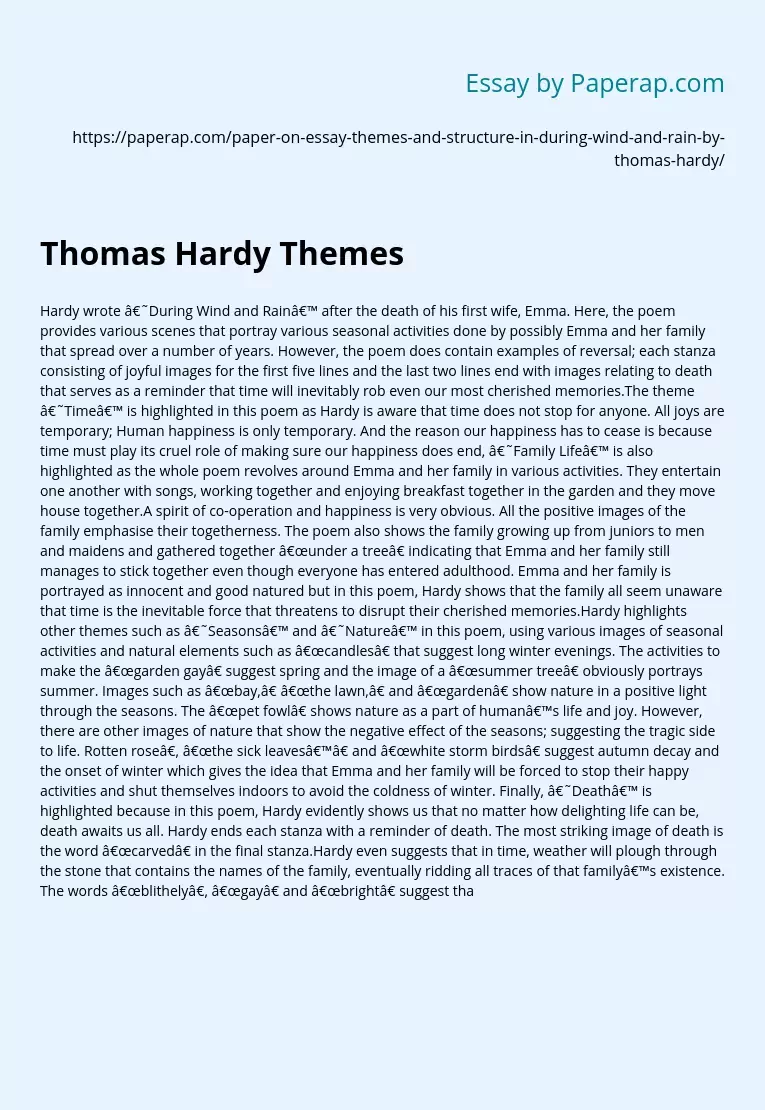Hardy wrote ‘During Wind and Rain’ after the death of his first wife, Emma. Here, the poem provides various scenes that portray various seasonal activities done by possibly Emma and her family that spread over a number of years. However, the poem does contain examples of reversal; each stanza consisting of joyful images for the first five lines and the last two lines end with images relating to death that serves as a reminder that time will inevitably rob even our most cherished memories.
The theme ‘Time’ is highlighted in this poem as Hardy is aware that time does not stop for anyone. All joys are temporary; Human happiness is only temporary. And the reason our happiness has to cease is because time must play its cruel role of making sure our happiness does end, ‘Family Life’ is also highlighted as the whole poem revolves around Emma and her family in various activities. They entertain one another with songs, working together and enjoying breakfast together in the garden and they move house together.
A spirit of co-operation and happiness is very obvious. All the positive images of the family emphasise their togetherness. The poem also shows the family growing up from juniors to men and maidens and gathered together “under a tree” indicating that Emma and her family still manages to stick together even though everyone has entered adulthood. Emma and her family is portrayed as innocent and good natured but in this poem, Hardy shows that the family all seem unaware that time is the inevitable force that threatens to disrupt their cherished memories.
Hardy highlights other themes such as ‘Seasons’ and ‘Nature’ in this poem, using various images of seasonal activities and natural elements such as “candles” that suggest long winter evenings. The activities to make the “garden gay” suggest spring and the image of a “summer tree” obviously portrays summer. Images such as “bay,” “the lawn,” and “garden” show nature in a positive light through the seasons. The “pet fowl” shows nature as a part of human’s life and joy. However, there are other images of nature that show the negative effect of the seasons; suggesting the tragic side to life. Rotten rose”, “the sick leaves’” and “white storm birds” suggest autumn decay and the onset of winter which gives the idea that Emma and her family will be forced to stop their happy activities and shut themselves indoors to avoid the coldness of winter. Finally, ‘Death’ is highlighted because in this poem, Hardy evidently shows us that no matter how delighting life can be, death awaits us all. Hardy ends each stanza with a reminder of death. The most striking image of death is the word “carved” in the final stanza.
Hardy even suggests that in time, weather will plough through the stone that contains the names of the family, eventually ridding all traces of that family’s existence. The words “blithely”, “gay” and “bright” suggest that Emma and her family are not aware of death likely to be present in their everyday life. Hardy seems to think that all the happy moments in life are bordered or framed by signs of death. Due to Hardy’s love for music, he often tried to incorporate a sense of melody to his poem. This is why ‘During Wind and Rain’ appear descriptive, lyrical and regular in form.The poem is made up of four seven-line stanzas, each one beginning with a tableau of conviviality and domestic concord among members of a family. These cheerful pictures, outlined with the simplest efficiency, are carried in the first five lines of each stanza.
The last two lines of each stanza (the sixth and seventh) act as a ballad-style refrain that looks away from the happiness to the inevitability of time’s erosion. Since the poem consists of seven lines and four stanzas, where seven suggests a week, just as four suggests the four seasons, thus the structure reinforces mentioned themes – ‘Seasons’ and ‘Time. Although the rhyming scheme stays fixed throughout the whole poem with each stanza, the rhyming scheme itself does not vary: a b c b c d a. In each stanza, the end of the first line, which is part of the happy tableau, will always rhyme with the end of the seventh line, where the doom-like message resonates. In a well-wrought poem, this kind of sonic equality will suggest a relationship beyond mere sound; perhaps suggesting the disharmony of time and death that affects life and its purest joy.
Thomas Hardy Themes. (2019, Dec 05). Retrieved from https://paperap.com/paper-on-essay-themes-and-structure-in-during-wind-and-rain-by-thomas-hardy/

